Fly Fishing Nymphs: Advanced Methods Used By Guides
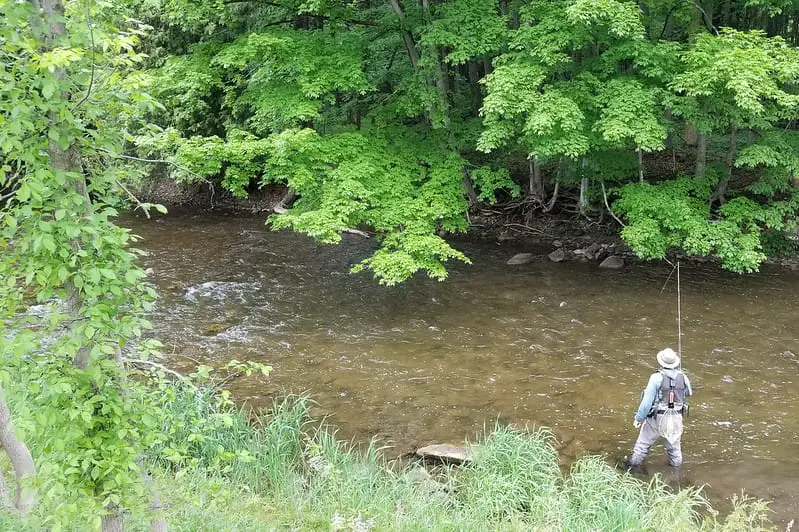
Trout will feed below the surface over 90% of their lives, which means fly fishing nymphs are the most effective way to fish for trout, and the nymphs are the best flies to use.
Although it may not be as exciting as catching fish on small dry flies, nymphs always catch larger fish than all other types of flies.
Nymphs imitate the aquatic insects that live below the surface, but nymphs can also include worm flies, fish eggs, terrestrials like beetles or crickets, and just about anything else that might be drifting below the surface and is small enough for a trout to eat.
Nymphing can be good for trout, steelhead, and salmon in rivers.
Types Of Nymphs
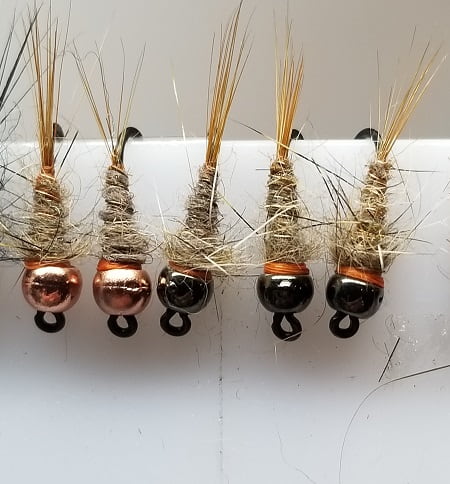
There are many types of nymphs that anglers can use when fly fishing. Weighted flies are popular but non-weighted nymphs can also be very good.
Non-bead head nymphs
I still use non-bead head nymphs, especially when fly fishing micro flies like midges. However, the bead head zebra midge is excellent.
Beadhead Nymphs
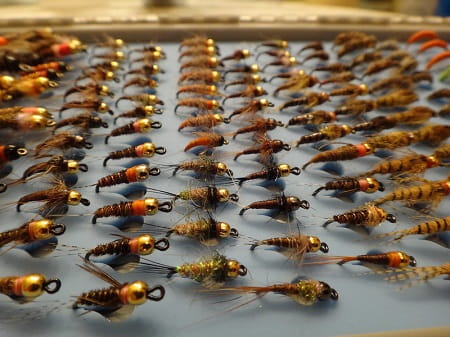
Beadhead nymphs are all the rage and they have been my go-to nymphs for fly fishing for over ten years.
Something about the shiny bead gets the trout’s attention.
The bead also adds weight which gets your nymph down fast and keeps it down. There are two types of beads, brass beads which are lightweight and are primarily for flash and attraction, and tungsten beads which are great for adding the maximum amount of weight to the fly.
I use mostly tungsten bead head flies now, especially when Euro nymph fly fishing.
Euro Nymphs
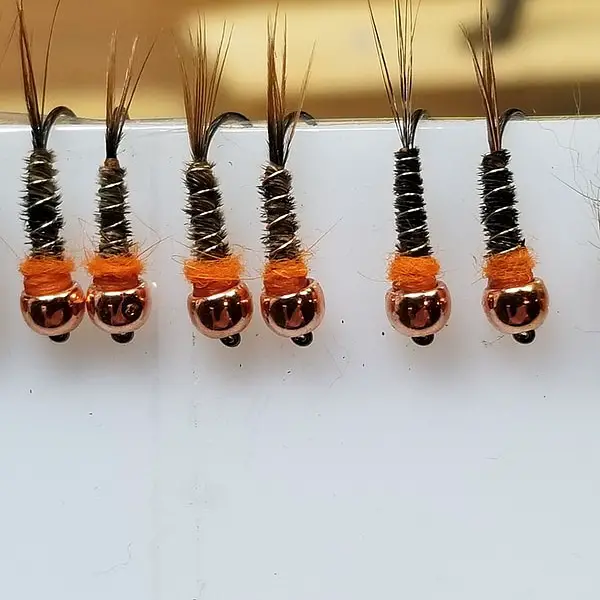
Euro nymphs are heavy weighted flies tied with tungsten beads, which help catch trout feeding underwater. Many Euro Nymp Flies have colored hot spots to attract hungry trout. Euro nymphing is a great way of trout fishing. All competition fly anglers use euro flies because they usually catch more fish.
- Frenchie
- WD-40
- Higas SOS Fly
- Polish Pheasant Tail Nymph
- Rainbow Warrior
- Surveyor Scud
- Iron Lotus
- Perdigon Flies
- Sexy Walts Worm
Emergers and Soft Hackles Nymphs
Often categorized as wet flies, dry flies, or their own fly category, “emergers”, these two styles deserve some attention because they are both fished below the surface and can be fished like nymphs.
Emergers depict insects in the emergence stage from nymph to adult dry fly stage, making their way to the surface for the next phase of their life cycle.
Trout capitalize on this moment of vulnerability and will eat these free drifting and helpless insects. Unlike most nymphs, emergers are either just beneath the surface or float within the film.
Soft hackles also simulate emerging insects. While they can be drifted passively, they’re typically swung through the current to attract eager trout. I often use soft hackle nymphs as the top fly on a two fly nymphing rig.
Popular Fly Fishing Nymphs For Trout
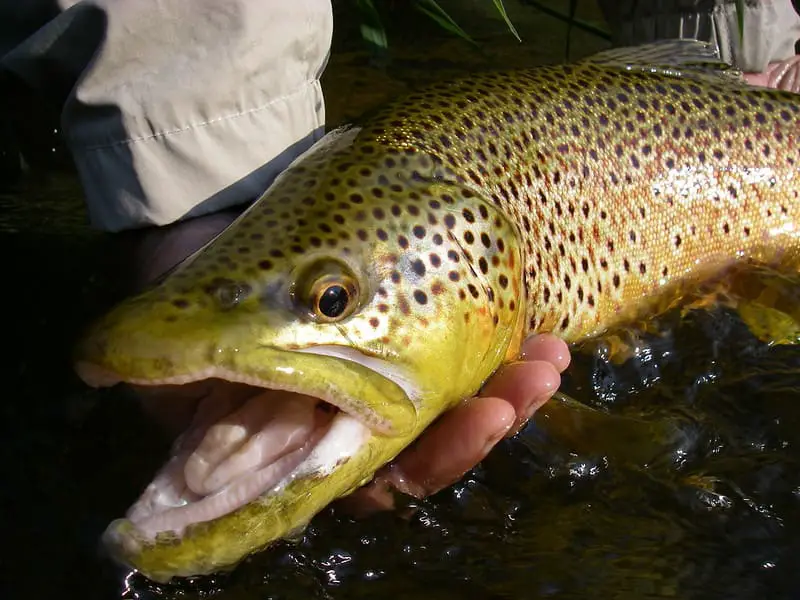
Some of the best trout nymph flies I use and recommend are:
- Copper John
- Pheasant tail and bead-head pheasant tail nymph
- Flashback Baetis Nymph
- Prince Nymph
- Hex Nymph
- Midnight Intruder fly
- San Juan Worm
- Glo Bug Egg Fly
- Hares Ear Nymph
- Walts Worm
- Utah Killer Bug
- Sow Bug
- Pat’s Rubber Legs Nymph
Some of the best nymph flies, and even the best modern dry fly patterns I have seen and used are from the Fly Fiend. You can check out The Fly Fiend Youtube channel.
My favorite fly patterns from The Fly Fiend are:
- Glassy Peacock Nymph
- Hot Tag Hares Ear
- The Bio Biot
- Ice Dub Pheasant tail
- D-Rib Stonefly
- Polo Club Pheasant Tail
- The Last Tag Nymph
- Flash Back Quill Baetis
- Olive Wired Soft Hackle
- Diamond Braid Biot Emerger
- Surveyor Scud
- UVP Nymph
How To Pick The Right Nymphs For Fly Fishing
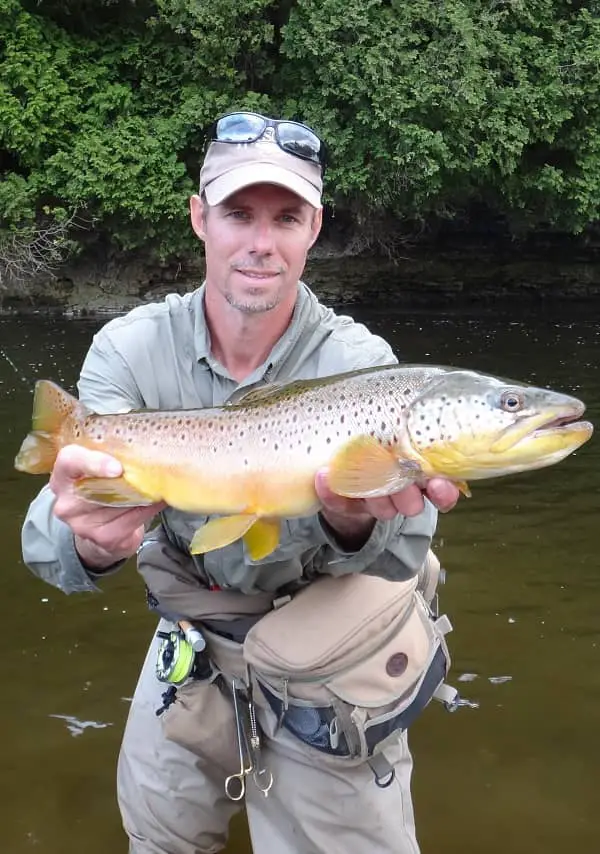
For many new anglers, picking the right flies for the river can be a hard decision. It’s even harder if the river you are fly fishing is new to you.
I’ll be honest and up front, most trout on most rivers will eat similar nymph flies. Some of the below tactics can help you decide which nymph flies will be most productive.
Keep your flies organized in one of my 12 most recommended fly boxes.
Use Existing Information From Multiple Sources
Using books, videos, magazines, and online fly-fishing articles can provide you with information on the river, the insects, and the best times to fish.
Many rivers will have hatch charts online that will tell you when to expect certain bug hatches. They often tell you the right size, color, and even the best time of day for these insects to appear.
Look Under Rocks
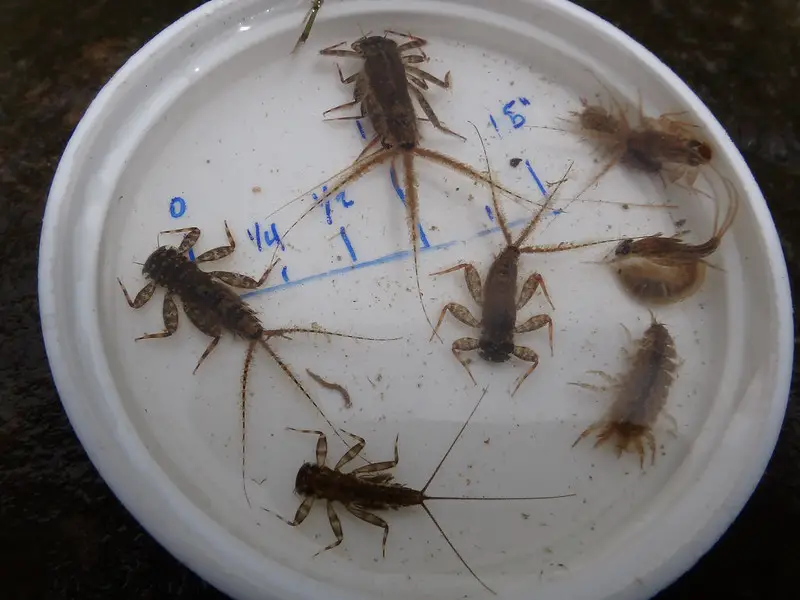
Although many experts will tell you to look under rocks to determine which nymphs are present in the river, I think this is actually a poor tactic for determining which nymphs the trout are currently feeding on. Nymphs under a rock may not be the same nymphs drifting in the current and matching the drifting nymphs are most likely to help you catch fish.
Looking under a rock for nymphs might be a good way to determine if there are more mayfly nymphs, Caddis larvae, or stonefly nymphs in that particular river.
However, ask tournament anglers how they determine the best flies for a new river, and they will have a different strategy, and so do I.
That strategy is to pick standard nymphs in various sizes and shades of brown or black, with some color hotspots, and fish them to see what the fish want, then rotate through flies until you find hot flies.
Ask Your Local Fly Shop
The local Fly shop is a wealth of knowledge on the most effective flies at the time, as well as productive spots, and productive methods.
The shops get all kinds of anglers coming in with reports on what is working and where the fishing is good or bad.
Ways To Do Nymph Fly Fishing
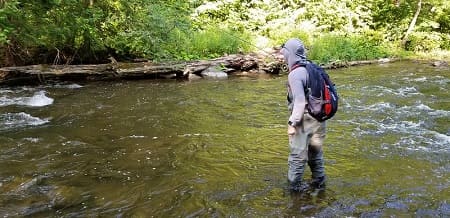
There are many ways to fly fish with nymphs; even dry fly fishing with a small dropper nymph below the dry fly is considered a type of nymph fishing. The dry fly can get eaten by trout, but it also acts like a strike indicator for trout biting the dropper fly.
The dry dropper rig is fun to catch trout, but there are some nymph methods are better than others.
Indicator Nymphing
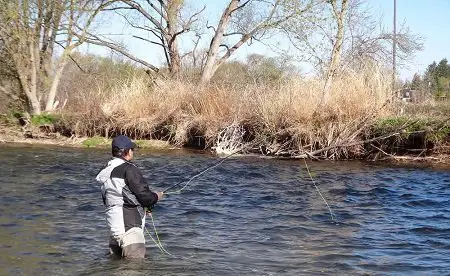
I consider myself an expert at indicator fishing since I’ve been indicator fishing for trout, steelhead, and salmon for 37 years as well as teaching it for over 20 years.
An indicator is a small floating version of a bobber placed up the leader above the fly at the appropriate depth to get the nymph in the strike zone.
Indicator fishing is by far the most popular style of nymphing. However, it is not the most effective. The strike indicator helps the angler detect bites, but it also drags the flies, and it can also add slack in the fly line and in the leader below the indicator.
Without a doubt, indicator nymphing does catch fish, and under the right conditions, it can be the most effective way of catching fish.
Standard Indicator fishing uses non-weighted subsurface flies, split shot on the line, and extra leader length to accommodate for angles. The goal is a natural drift.
Tight Line Nymphing, Euro Nymphing, And Modern Nymphing
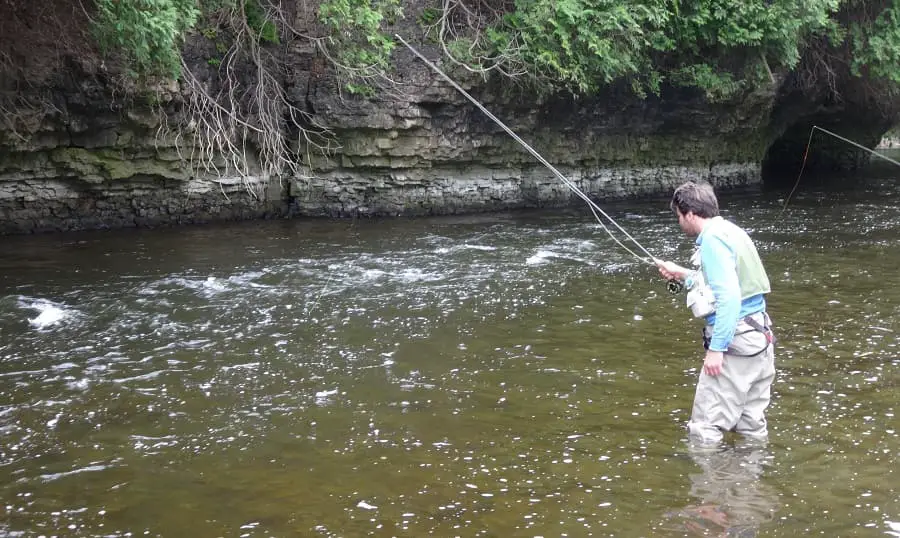
These nymphing methods are all similar. The idea is to keep the fly rod high and the leader up and off the water with the leader under tension and to not use a floating strike indicator.
Instead, tight line control and strike detection are done using a colored piece of line known as a “sighter”.
This method is often the most effective method of nymphing, which is why all the top competition fly anglers use it.
Done properly, euro nymphing rigs can improve your depth control and the speed of the fly. Because the line is tight, strike detection is greatly improved.
Swinging Nymphs
Swinging nymphs is also known as the wet fly swing, and in my opinion, is not true nymph fishing. However, a top competition angler taught me that swing you fly at the end of your dead drift can resemble an emerging nymph resulting in more trout.
Stripping Nymphs
When still water lake fishing, a fly angler can nymph fish using short, subtle stripping motions to swim the nymph through the water column. At time, quicker stripping can trigger bites. A special lake nymph rig is used.
Most anglers will not strip in nymphs in the river.
Tips For Fishing Nymphs Successfully
I could write entire pages on fishing nymphs more successfully, and I have, but here are some of the top tips.
1. Be Quiet, Go Slow, Stay Low
It doesn’t matter if you have a great nymph on the line, or if you use the best method for the spot you are fishing, or if you perfect all the tips below, if you are not quite and you spook the trout, your chances of catching fish is greatly reduced.
2. Treat Every Bump As A Strike
I tell my clients when fly fishing with nymphs, you need to set on everything and anything, and you need to set fast without any hesitation.
I set the hook on subtle takes by looking for any sign of the indicator twitching, pulling, or even a hesitation in the drift. A wise guide once said, it’s not the guy that gets the most bites that catch the most fish, it’s the guy that set the hook the most.
I guarantee you that most anglers miss trout bites without even knowing it.
3. Setting The Hook: Set Often Set Fast, Set Properly
It is critical to set the hook fast since a trout can spit out a fly in less than 2 seconds. It’s also important to set the hook with just the right amount of speed so the fly doesn’t come flying out of the water.
It’s also important to set the hook in the right direction.
I discuss how to set the hook properly when fishing with indicators and slack on the line and when tight line fishing, because flies in the trees behind them is a common frustration of many fly anglers.
4. Getting Your Nymph Flies Down Enough
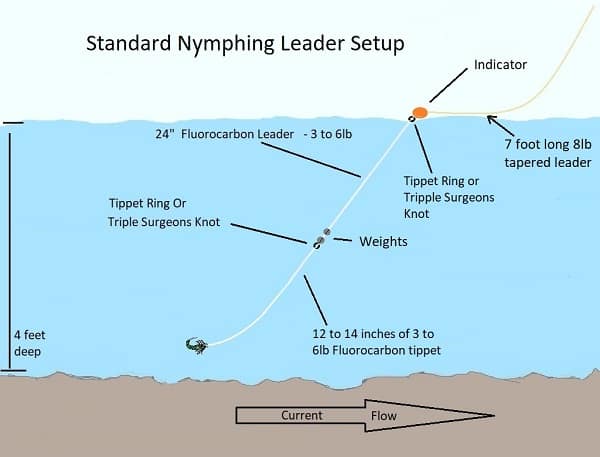
Trout spend the majority of the time close to the bottom, especially big trout, and studies indicate that trout feed upwards and sideways 87% of the time.
This means you must get your nymphs deep enough but DO NOT drag bottom. Your nymph flies should be 12 to 20 inches off the bottom for maximum results.
To cover the water column better, use a point fly on the bottom and another attractor nymph 20 to 30 inches up the line. Soft hackle flies, a mayfly nymph pattern or small nymph patterns are ideal for the upper fly.
A nymph tied on a jig hook is good for the bottom fly because the hook is up and that means less snags.
5. Minimize The Line On The Water
Line control means mending the fly line and the leader on the surface, or even keeping as much line off the water as possible. Mending is repositioning the line to get a better drag-free drift. Drag can speed up the flies, and that can deter fish from biting.
The more line on the water, the more likely it will drag, but also the more slack you need to take up on the hookset.
Keeping all the line off the water provides a better drag-free drift, better strike detection, and a better hookset.
6. Speed Control Is Critical
One of the major reasons that competing fly anglers all use Euro nymphing techniques is because of the ability to control the speed of the nymph flies. The bottom current is sometimes over 50 percent slower than the surface current, so when your indicator is being dragged along by the surface current, your nymph is also going so fast that most big fish will not bite your fly.
In my opinion, controlling the speed of your fly is the most critical thing you can do when nymphing.
Using a proper nymph rig can help control the speed and presentation of your fly.
Setting Up a Nymph Fishing Fly Rod for Success
You can use a regular fly reel, with a standard floating fly line with a tapered leader, but there are better long line leaders that are made with multiple diameters for tippet.
The best fly rod is 10 feet long.
When to Fly Fish with Nymphs
Some of my clients ask me when is the best time to fish nymphs, or how do I know if fishing nymphs is best or if fly fishing with dry flies is best or if streamer fishing is best.
To be honest, you can fish nymphs anytime with success. However, if the trout are rising like crazy for floating flies, you might as well take advantage of dry fly fishing.
But, if no fish are rising, I almost always start with nymphs.
Where to Buy Nymphs for Fly Fishing
Check out Trident fly fishing, Avid Max, and Amazon to buy your flies. Your local fly shop is also the best place for fly patterns that best match the local aquatic insects. They will also have the material so fly tiers can tie up their own flies.
Tight Lines
Graham

Very interested in your nymphing articles, specifically European, Spanish, French, excetera. Would be interested in bringing a few friends to you for a class or scheduling an outing with you if that’s your preferred method of instruction. Please provide a phone number where I can reach you to discuss further. Thanks
Hi Eric, I will be adding more about those nymphing methods in the future, right now I’m swamped with guiding and keeping my guides on track so it might be later in the winter months. I usually offer 3 or 4 nymphing classes in the spring in my area, they are often sold out so check my guide website in February for updated class lists and times.
This is a very well done and informative post. I envy you for having taken a class with David Arcay. There are few better anglers in the world. I often fish like the comp guys do, with micro-thin leaders and 6 to 7x tippets. But I also frequently fish with a drop shot rig, and, frankly, I tend to do better with the latter. Could you tell me what kind of nymphing rig works best for you day in day out? I know that different circumstances favor different rigs, but if you had to choose one nymphing style, which one would it be?
Hi Alex,
I tell my clients that the nymphing rig that I use the most, or the style of nymphing that works best for me would closely resemble Spanish nymphing. Or if not the Spanish nymphing methods you would see in French nymphing. However, as you stated it’s important to adjust your method and rig based on the type of water that you fish. The key with your setup and your method is that your flies get into the strike zone fast, they stay in the strike zone as long as possible, and they are moving at the most natural speed possible. If you are doing best with a drop shot type rig it could simply mean that is the rig that gets down the best for the type of water that you fish.
Thanks for you reply, Eric. Could I ask you another question? Well known US comp anglers such as Devin Olsen and Lance Egan use long tippets (up to 8ft.) to which they frequently a “secondary” sighter in the sense of wax (Skafar’s, for example). As I understand it, the European comp anglers tend to use a much shorter tippet (3-4′) and use sections of their sighter like a dipstick to gauge how deep their nymphs are. How do you stand? Do you prefer long tippets with wax, of short tippets with differently colored sections of sighter?
Hi Alex,
FYI, there is a now a Euro Nymphing Page with my basic leader set-up.
Remember that Devin and Lance are experts so their leaders might be difficult for beginners to use or understand. When I was training with some pro tournament anglers they used a similar setup and I use a similar setup when I’m training advanced anglers.
Some advanced nymph guys will use these extra-long tippets or an extra-long thin leader with multiple sighter sections so they cab quickly be able to go from very shallow water to very deep water without a leader change.
With multiple sighter sections, the lower sighter is used when fishing shallow water but then the angler can easily go from fishing 3 feet deep to fishing 9 feet deep using a second sighter higher up the line. The second sighter can be sighter tippet, or wax, or tippet marker, etc.. When fishing deep water with a double sigher setup, the low sighter will be buried deep in the water while the upper sighter, or wax, or tippet marker, or whatever they use, will be up and out of the water and will be used to gauge speed and depth in those deeper sections.
When guiding new anglers to euro nymphing, my entire leader is about 12 to 16 feet long and the tippet length depends on the average depth of the river that I’m fishing. If most spots are 3 feet deep I try to keep my client’s tippet below the sighter short and about 2 to 3 feet long. It’s usually easier to see the sighter if it’s closer to the water and with a shorter tippet, anglers are less likely to constantly drag bottom. Dragging bottom is bad.
With a short tippet, you can gauge your depth by how high or low the sighter is off the water, but I rarely use the sighter as a dipstick to gauge depth.
Hope that makes sense.
Good luck,
Graham
Great blog and article – one of the most informative on the subject I’ve seen! What knot do you use for the bottom fly above the weight in the bottom bouncing setup?
Hey Joe,
For the dropper tag with the weights on it, I will use a Davy Knot or an Improved clinch knot. For most line-to-fly connections, I will use a double Davy Knot or an Improved Clinch Knot.
Good Luck,
Graham